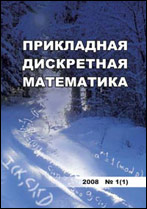|
|
Prikladnaya Diskretnaya Matematika, 2011, supplement № 4, Pages 9–11
(Mi pdm302)
|
 |
|
 |
Theoretical Foundations of Applied Discrete Mathematics
The number of bent functions on the minimal distance from a quadratic bent function
N. A. Kolomeeс
Novosibirsk State University, Novosibirsk
Abstract:
We are interested in how to construct bent functions by slight modifications of an initial one. The answer to this question is directly connected with the studying bent functions on the minimal Hamming distance from a given bent function. Here, we describe all bent functions on the minimal distance from a quadratic bent function and calculate exactly the number of them.
Citation:
N. A. Kolomeeс, “The number of bent functions on the minimal distance from a quadratic bent function”, Prikl. Diskr. Mat., 2011, supplement № 4, 9–11
Linking options:
https://www.mathnet.ru/eng/pdm302 https://www.mathnet.ru/eng/pdm/y2011/i13/p9
|

| Statistics & downloads: |
| Abstract page: | 202 | | Full-text PDF : | 77 | | References: | 36 |
|




 Contact us:
Contact us: Terms of Use
Terms of Use
 Registration to the website
Registration to the website Logotypes
Logotypes









 Citation in format
Citation in format 